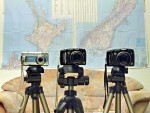If there’s one area where you would be spoiled for choice, it would be choosing a camera. I made my choice, and it turns out that I made a good one, but it is many a snapshot and many a line of programming later that I would be able to say that. But, rather than go into all that, I can give a couple of tips about choosing a camera, any camera, in any case. Have a look for:
Zoom. A good zoom saves having to get up close. A moderate zoom of 3-4 is good for a start, and a zoom of 10 or more borders on the telescopic, if only at the Galilean level. However, take care to understand how the zoom is measured. I have seen a number of cameras with a claimed zoom of, say 14, but this is measured against a default focal length of 28 mm, instead of the usual 36 mm. This gives an effective focal length of 392 mm at zoom 14, which is not much more than a zoom of 10 would produce from a starting point of 36 mm (i.e. 360 mm). Keep in mind that a camera with a focal length of 28 mm is a wide angle device; the question is then whether you need a wide-angle camera. And only optical zoom counts here; the digital type is worthless.
Macro. A feature that allows really, really close-up shots (cm range) is useful for the microscopic end of things.
Batteries. My logic behind choosing cameras that run off ordinary batteries, is that there might come a time when the camera’s custom battery pack would give up the ghost and that the only alternative to utter despair would be run-of-the-mill batteries. That has yet to happen, but a further advantage of batteries, especially rechargeable ones, is that you can choose a reliable brand, instead of having to rely on the camera manufacturer’s choice. A battery meter is not essential; just an indication before the batteries expire.
Memory card. Memory cards of the sort that require exact positioning of holes over pins generally result in the pins becoming bent; better look for cameras that use SD cards or similar, which have few contacts and can easily be slotted in and out.
Having said that, cameras should allow manual control over ISO (80-1600), shutter speed (0.001-15 s), aperture (f2.8-8), focus (0-∞) and exposure bias (± 2), as well as having automatic options. Video in reasonable quality, with sound recording. Time-delay shooting. And forget all the face-detection, special modes, “my colours” and print buttons. They won’t be missed.
As we shall see, such a camera in the price range under €150 would have a number of drawbacks that will have to be overcome, depending on the use the camera is put to. But I’d much rather drop a camera of that price into a river than one costing ten or twenty times as much, wouldn’t you?

